Alan M. Petrillo
When it comes to stabilization systems for aerial ladders and platforms, the stability of the vehicle is the chief element of concern for manufacturers, who still take advantage of technology to add safety and performance features to the device.
Stabilization System Types
The systems fall into four main types: H style, A-frame style, underslung, and gull wing. Some manufacturers use the term X style, which is synonymous with the A-frame style.
“The most common is the H style, where the outrigger comes out horizontally and then down to the ground,” says Tim Smits, senior national sales manager for Pierce Manufacturing Inc. Smits says. “There’s also the A-frame style, where the stabilizer comes out at downward angle; the underslung system, which is built into the torque box and comes out horizontally and then down to the ground; and the gull wing type, which stores vertically and drops straight down to the ground.”
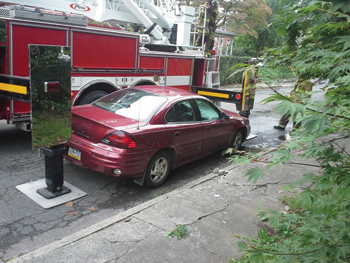 |
|
(1) Pierce Manufacturing Inc. uses H-style outriggers on most of
|
Applying Stabilization Systems
Pierce uses the H style stabilizers on most of its aerials, Smits notes, although it does use the A-frame style on its Skyboom product. “The H style stabilizers allow a higher outrigger strength-to-weight ratio,” Smits observes, “so you can use lighter materials in the stabilizers, like the high-strength steel Pierce uses. Underslung stabilizers are much heavier, and with that type all the jacks have to be out in order to properly stabilize the vehicle.”
Smits says that another advantage to H-style stabilizers is that each can be operated independently, allowing the aerial operator flexibility in placement, as well as being able to short jack the truck and still operate the aerial. “The H style runs out horizontally and then down to the ground,” Smits points out. “The underslung and A-frame types go out at an angle to the ground and might be blocked by a curb or other impediment.”
Tony Mastrobattista, aerial sales manager for the North region at Spartan ERV, says the higher an operator can lift the aerial apparatus off the ground, the more irregular, steep and sloped terrain he can negotiate. Mastrobattista says Spartan ERV uses H-style outriggers as well as X type (A-frame style). “An H-style outrigger typically lifts the truck 14 inches,” he says, “but with an X-style system, you can get it up to 20 inches off the ground.”
Mastrobattista notes that generally for a 75-foot aerial on a single rear axle of nearly every brand, two rear outriggers are standard. “Sometimes two front outriggers or downriggers that extend straight down are selected as an option by agencies that operate in steep terrain areas,” he adds. “But larger vehicles always have four outriggers, usually of the H type, that extend well away from the truck.”
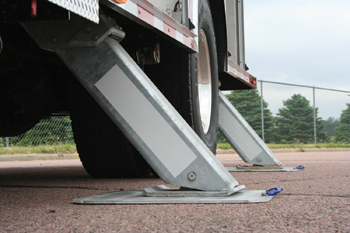 |
|
(2) These A-frame outriggers are on a Rosenbauer pumper fitted
|
Mike Harstad, aerial products manager for Rosenbauer, says his company uses H- style outriggers on all its traditional aerial ladder and platform products. “However, we use an A-frame outrigger on a pumper with an extended aluminum boom as an elevated water supply, but there’s only one movement to that outrigger so it extends out at an angle until it contacts the ground,” Harstad says. “Our newest product is a tractor-drawn aerial that uses a modified A-frame outrigger system that’s a hybrid between an H and an A, which gets the footpad out farther than a typical A but is shorter than the average H. An extension beam takes the outrigger away from the truck body and the down jack extends out like our standard A-frame.”
At Ferrara Fire Apparatus, marketing director and aerial product manager Paul Christiansen says its aerial ladders and platforms carry out-and-down H-style jacks, with different model vehicles using different numbers of outriggers.
“Our 57-foot and 77-foot ladders use two H jacks in the rear, while longer ladders use four H jacks,” Christiansen says. “The exception is the 100-foot aerial ladder we build for the Fire Department of New York that uses two rear H jacks.” Ferrara aerial platforms-85- and 100-foot lengths-have four H-style outriggers.
Chuck Glagola, aerial product specialist for Smeal Fire Apparatus, says that all the outriggers on the rear of Smeal aerial devices are H-style jacks, with the cylinders enclosed in a box to protect them. “On our 75-foot ladder, the rear H jacks have 16- to 18-foot jack spread and the front jacks go straight down,” Glagola says. “Our UT 100-foot ladder has front jacks straight down and 18-foot-jack-spread H jacks at the rear, while our 105-foot and 125-foot ladders have four H-style jacks each.” For Smeal platforms, the devices all carry four H-style jacks.
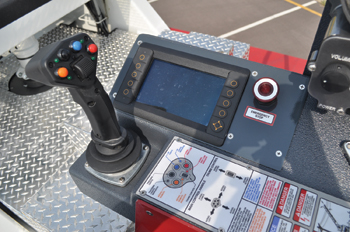 |
|
(3) All Rosenbauer aerial ladders and platforms are equipped with
|
Different model KME aerials carry different jack spreads, according to Pete Hoherchak, aerial product manager for KME. “Our 79-foot ladder comes with a single set of H outriggers at the rear with a 16-foot stance, or for a 750-pound tip load, two 14-foot stance rear H outriggers plus two front downriggers behind the cab,” Hoherchak says. “Our 103-foot ladder has 18-foot rear H outriggers and two front downriggers, while our 109-foot and 123-foot ladders have H outriggers front and rear that are 24-inch-deep penetrating, allowing the aerial to level at an 11-degree side slope.” KME’s various platforms have four H-style outriggers.
Joe Hedges, product manager for aerials and chassis at E-ONE, says his company uses H style, A-frame, and underslung crisscross jacks on its aerial products. “The most important thing on jacking with our underslung criss-cross system is its small profile,” Hedges says. “When the jacks extend, a small foot comes out instead of a large H jack.”
Hedges notes that the underslung jacks come out as little as 11 feet on a 100-foot ladder to 15 feet, six inches on a 100-foot platform. “The underslung is easy to set up, gets around obstacles well, and allows for a compartment over the jack leg,” he says. “It also provides a lower center of gravity because the steel structure is down under the frame.”
E-ONE’s 50-foot boom device uses A-frame-style jacks, Hedges notes, while its HP75 and HP78 ladders use rear H- style outriggers with a 16-foot spread. However, the HP95 midmount platform uses four jacks that drop straight down and one set of underslung jacks under the turntable. “The jacking configuration allows us to put the vehicle in a tight space and only have one set of extending outriggers,” Hedges observes.
E-ONE’s HM100, HP100, CR100, 110-foot ladder, CR137, and 95 Dash platform all use front and rear underslung outriggers of varying extension widths.
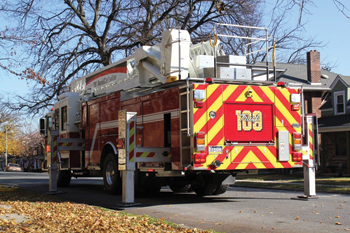 |
|
(4) This KME 109-foot AerialCat ladder uses four H-style
|
Jack Placement
Smits notes that although Pierce has experimented with lasers for designating the placement of outrigger pads, the company has found the laser beams difficult to see in a driver’s mirrors. “We’ve prepositioned spotlights on the sides of trucks that shine on the spot where the outriggers will be deployed,” he adds, “so the operator will know if there’s an obstruction.”
Spartan ERV offers a number of ways to assist operators in placing jacks, Mastrobattista says. “We offer a laser outrigger spotting system that places a red laser dot on the ground where the outrigger footplate will land so the operator can quickly determine if he’ll have enough space to deploy the outriggers fully,” he notes. “We also offer an automatic leveling system that lifts and levels the truck to a safe and proper operating system, taking the guesswork out of leveling the vehicle.”
Mastrobattista points out that Spartan ERV has a ground pressure sensing system in the jack assembly that senses about 4,000 pounds of ground force pressure. The system connects to the aerial device’s interlock and a minimum amount of pressure must be satisfied to all outriggers to provide power to operate the aerial, he notes.
Harstad says that Rosenbauer offers an automatic leveling system for its aerials, where the jacks are put in contact with the ground, an auto leveling button is pushed, and the truck levels itself.
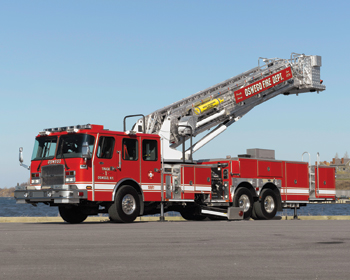 |
|
(5) E-ONE’s jacking system for this Oswego (NY) Fire Department
|
All Rosenbauer aerial ladders and platforms have a Smart Aerial electronic system that allows short jacking through live active load monitoring, Harstad says. “An operator can set the aerial in a short jack position and still be able to work over those short jacks at the full rated tip capacity without any override,” he says. “The system constantly calculates what is safe so it can’t put the truck in an unsafe position. The truck will stop before that happens.”
Glagola adds, “The key with the placement of our front jacks is you don’t have to worry about having the cab facing uphill, as long as you get the device in a level condition. The front jacks on both our rear-mount and midmount aerials are placed ahead of the pump directly behind the cab.”
Hoherchak says that all KME’s models are available with a short jack system called the Rotation Safety System, which is electronically controlled. “The operator sets up the truck and if he can’t jack out fully on the opposite side of the fire, the system will allow him to operate 180 degrees to the truck’s centerline to the fully jacked side but will stop if he tries to rotate to the short jacked side,” he says.
 |
|
(6) Smeal Fire Apparatus built this 75-foot aerial ladder on a single
|
KME also offers lasers mounted to the vehicle’s body that shine a laser spot on the ground to indicate the approximate position where the outrigger is to be placed. “A focused beam spotlight can accomplish the same thing,” Hoherchak notes. “It’s mounted on the body and shines down to where the outrigger should be. We also have camera systems that can be used on both sides of the truck and tied into displays in the cab, the rear vision system, or multiplexed throughout the truck.”
Hedges points out that the HP75 and HP78 ladders both can be short jacked when fitted with electronic controls that limit rotation off the short jacked side of the vehicle, while still allowing about a 200-degree aerial device swing on the fully jacked side.
 |
|
(7) Spartan ERV has a ground pressure sensing system in its jack
|
ALAN M. PETRILLO is a Tucson, Arizona-based freelance writer and is a member of the Fire Apparatus & Emergency Equipment editorial advisory board. He served 22 years with the Verdoy (NY) Fire Department, including in the position of chief.

